AUGUSTE RODIN
- his life, his work (7)
|
|
|
|
|
1903
|
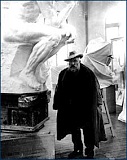 Rainer Maria Rilke publishes the book 'Auguste Rodin'
and Judith Cladel 'Auguste Rodin: Pris sur la Vie'. Rainer Maria Rilke publishes the book 'Auguste Rodin'
and Judith Cladel 'Auguste Rodin: Pris sur la Vie'.
Rodin becomes Commander of the Legion of Honor and follows up
Whistler as President of the International Association of Painters,
Sculptors and Engravers.
Exhibitions in Berlin, London (the big 'Thinker' in plaster and a
small one in bronze), Venice and New York.
|
|
1904
|
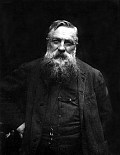 Through a studio assistant,
the Finish sculptress Hilda Flodin, with whom he sometimes spends the
night, he is introduced to the young Welsh painter
Gwendolin John, sister of the painter Augustus John. Rodin asks her to
model for 'Whistler's Muse' and starts a sexual affair with her as well. He regularly visits
her in her apartment, till he is bored by these hasty love hours and
Gwen's emotional dependency. During their relationship, Gwen has written him
over 2,000 letters. Through a studio assistant,
the Finish sculptress Hilda Flodin, with whom he sometimes spends the
night, he is introduced to the young Welsh painter
Gwendolin John, sister of the painter Augustus John. Rodin asks her to
model for 'Whistler's Muse' and starts a sexual affair with her as well. He regularly visits
her in her apartment, till he is bored by these hasty love hours and
Gwen's emotional dependency. During their relationship, Gwen has written him
over 2,000 letters.
In London, he meets Claire Coudert, Duchesse de Choiseul. She is about 25 years
younger than Rodin and brings a new vitality into his dusty rooms. She
starts working for
him as impressaria and promotes his sales in the USA. Through her efforts,
the prices of his work go up enormously and within a few years, his annual
income increases from 60,000 till 400,000 Francs.
Henri Asselin, a friend of Camille Claudel's supporter Blot, visits Camille
in her atelier on the Quai de
Bourbon; she believes Rodin is
stealing her ideas and has ordered to kill her.
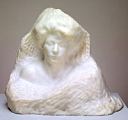 Rodin works on the bust of 'Eve Fairfax' and on 'The Hands of Lovers'.
Rodin works on the bust of 'Eve Fairfax' and on 'The Hands of Lovers'.
Exhibition at the Metropolitan Museum and in Düsseldorf.
A monumental plaster version of the 'Thinker', enlarged by
Henri LeBossé, is exhibited at the
Spring Salon of the National Society of Fine Arts, May 1904 in Paris,
under the central dome of the Grand Palais Museum. Gustave Geffroy writes in the Revue
blue of 17 Dec. 1904:
"If he were to stand up and walk, the ground under his feet would
tremor and scores of soldiers would part for him."
|
|
1905
|
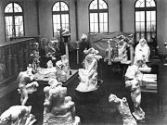 On 16 Jan. 1905, a bronze-painted plaster of the 'Thinker', put in front
of the Panthéon on 28 Nov. 1904, is destroyed by a confused person
called Poitron.
On 16 Jan. 1905, a bronze-painted plaster of the 'Thinker', put in front
of the Panthéon on 28 Nov. 1904, is destroyed by a confused person
called Poitron.
 On 15 September, Rainer Maria Rilke becomes his
private secretary and moves to Meudon.
On 15 September, Rainer Maria Rilke becomes his
private secretary and moves to Meudon.
Rodin buys the ruins of the Château d‘Issy, the 18th century
castle in Touraine where he had often stayed with Camille. He hopes to reconstruct the building to
establish a museum with his collection
of antique sculpture; this project cannot be realized for financial
reasons and so
only the storefront is reconstructed.
In December, Camille has a show of 13 works in Blot's gallery. The day
after the vernissage, she has a terrible temper. Her brother Paul is
worried about her state of mind.
Rodin receives the honoraray doctor degree of the University of Jena.
Exhibitions in Luxembourg, Boston and Venice.
Completion of the bust of 'Georges Geffroy' and 'Eve Fairfax'.
|
|
1905
|
Gustav Klimt paints the 'The three
Ages', inspired by Rodin's 'She was once the beautiful Héaulmière'.
Scandal about the first Manifesto of the Fauves, led by Henri
Matisse.
Die Brücke is formed as group of artists.
|
|
1906
|
A monumental bronze cast of 'The Thinker', financed by
public subscription, is installed in front of the Panthéon. In
1922, it will be removed to the garden of the Musée Rodin.
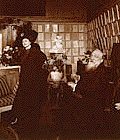 Rodin's friendship with the Duchesse turns into a love affair. She convinces
him to buy a grammophone and hear music records. She makes Rodin feel like
a younger man again, but she also tends to isolate him from his friends and shows great interest in his
heritage.
Rodin's friendship with the Duchesse turns into a love affair. She convinces
him to buy a grammophone and hear music records. She makes Rodin feel like
a younger man again, but she also tends to isolate him from his friends and shows great interest in his
heritage.
Together with Rilke and the painter Zuloaga, Rodin travels to Toledo,
Madrid, Córdoba, Sevilla and Pamplona; on 12 May he ends his
friendship with Rilke, because he feels Rilke is taking advantage of
Rodin's contacts in the art world; the Englishman Anthony Ludovici follows
up Rilke as Rodin's personal secretary.
Rodin receives the honoraray doctor degree of the University of Glasgow.
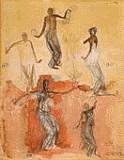 Drawings of the 'Cambodian Dancers' on the occasion of the arrival of
the Royal Ballet of Cambodia in Paris and Marseille; Rodin also draws in the
dancing school of Paris. During the last decade of his life, Rodin
develops an intuitive style of drawing. He liberates himself from the
heavy black lines of his earlier drawings and from the pessimist
ambivalence of his sculptural work. Without taking his eyes from the
model, he swiftly produces numerous pencil sketches, focusing on seductive
poses and the female sex. A series of these erotic drawings, presented by
Rodin to Count Kessler, is exhibited in Weimar in January 1906 and
provokes a scandal, which leads to Kessler's dismissal as presiding
curator of the Weimar Museum.
Drawings of the 'Cambodian Dancers' on the occasion of the arrival of
the Royal Ballet of Cambodia in Paris and Marseille; Rodin also draws in the
dancing school of Paris. During the last decade of his life, Rodin
develops an intuitive style of drawing. He liberates himself from the
heavy black lines of his earlier drawings and from the pessimist
ambivalence of his sculptural work. Without taking his eyes from the
model, he swiftly produces numerous pencil sketches, focusing on seductive
poses and the female sex. A series of these erotic drawings, presented by
Rodin to Count Kessler, is exhibited in Weimar in January 1906 and
provokes a scandal, which leads to Kessler's dismissal as presiding
curator of the Weimar Museum.
Rodin continues working on 'Ugolino'.
|
|
1907
|
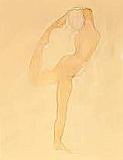 At the same time as Mark Twain, also Rodin receives the
honorary doctor degree of the University of Oxford. At the same time as Mark Twain, also Rodin receives the
honorary doctor degree of the University of Oxford.
Reconciliation with Rilke; a few years later Rilke assesses Rodin's
situation as follows:
"Rodin was lonesome because of his fame. And the
increasing fame maybe made him more lonesome."
First great exhibition of his drawings in the Galerie Bernheim Jeune
in Paris.
Further exhibitions in Barcelona, Budapest, London, New York, Berlin and
Venice. |


|